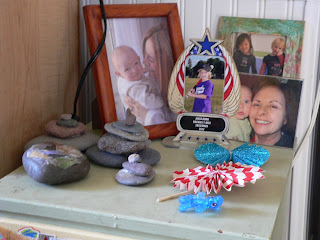I wonder what a cicada's song will mean for my daughter, years from now. Will she think about the box of cicada exoskeletons (a creepy, but cool, collection) she's saved over the years? Will she think about the time she got so mad and ran away from home (but let me accompany her), to a grassy boulevard a couple of blocks away where we sat in the shade of trees and listened to cicadas? Will she think about the adult cicada she "rescued" from a sidewalk, only to find that its abdomen was missing so it would probably die soon anyway? Or will her summer memories, triggered by cicada songs, have nothing to do with the insect at all?
I hope she remembers how much time I was able to spend with her in the summer, how we ambled through alleys, scootered all over the neighborhood, biked together, planted gardens, raised monarchs and praying mantises, and picked and ate raspberries and ground cherries. I hope she will still love the crab apple tree in our front yard, the flagstones she overturned in her search for bugs and worms, and the swing hanging from the white pine. Perhaps she will think of the sparrow she rescued from the dog, the bunnies she rescued from window wells, or the secret space between the garages that she called "Ponyville."
How can we help children make those memories and connect to the natural world in meaningful and joyful ways? Does it matter? The two greatest indicators of responsible environmental behaviors in adults are spending time outdoors as a child and having a parent or other role model who values the natural world (Louise Chawla). It doesn't have to be complicated. We don't have to go out of the city or have a degree in environmental education to cultivate a child's love of nature. It's already there. We just have to slow down, notice what kids are noticing, and give them a little time and space to explore.
What will your children remember of summer?
A few interesting cicada facts:
- Here in Minnesota, we have cicadas that are called dog day (annual) cicadas. They occur every year. The 13- or 17-year periodical cicadas do not occur in Minnesota.
- Only the males make the humming/buzzing sound. They do this to attract females.
- Cicada nymphs (young cicadas) feed on tree roots beneath the ground.
- Adult cicadas only live a few weeks - just long enough to mate and lay eggs.
- When you find a cicada with part of its body (the abdomen) missing, this is most likely due to a fungus called Massospora.












